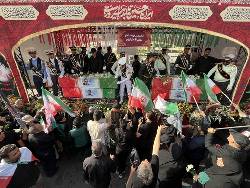DUBAI, United Arab Emirates (AP) — Hundreds of thousands of mourners lined the streets of downtown Tehran on Saturday for the funeral of the head of the Revolutionary Guard and other top commanders and nuclear scientists killed during a 12-day war with Israel.
The caskets of Guard's chief Gen. Hossein Salami, the head of the Guard’s ballistic missile program, Gen. Amir Ali Hajizadeh and others were driven on trucks along the capital's Azadi Street as people in the crowds chanted: “Death to America” and “Death to Israel.”
Salami and Hajizadeh were both killed on the first day of the war, June 13, as Israel launched a war it said meant to destroy Iran's nuclear program, specifically targeting military commanders, scientists and nuclear facilities.
State media reported more than 1 million people turned out for the funeral procession, which was impossible to independently confirm, but the dense crowd packed the main Tehran thoroughfare along the entire 4.5 kilometer (nearly 3 mile) route.
There was no immediate sign of Iran’s Supreme Leader, Ayatollah Ali Khamenei, in the state broadcast of the funeral. Khamenei, who has not made a public appearance since before the outbreak of the war, has in past funerals held prayers for fallen commanders over their caskets before the open ceremonies, later aired on state television.
Top officials are among the mourners
Iranian Foreign Minister Abbas Araghchi was on hand, and state television reported that Gen. Esmail Qaani, who heads the foreign wing of the Revolutionary Guard, the Quds Force, and Gen. Ali Shamkhani were also among the mourners.
Shamkhani, an adviser to Khamenei who was wounded in the first round of Israel's attack and hospitalized, was shown in a civilian suit leaning on a cane in an image distributed on state television's Telegram channel.
Iran’s Revolutionary Guard was created after its 1979 Islamic Revolution. Since it was established, it has evolved from a paramilitary, domestic security force to a transnational force that has come to the aid of Tehran’s allies in the Middle East, from Syria and Lebanon to Iraq. It operates in parallel to the country’s existing armed forces and controls Iran’s arsenal of ballistic missiles, which it has used to attack Israel twice during the Israel-Hamas war in the Gaza Strip.
Over 12 days before a ceasefire was declared on Tuesday, Israel claimed it killed around 30 Iranian commanders and 11 nuclear scientists, while hitting eight nuclear-related facilities and more than 720 military infrastructure sites. More than 1,000 people were killed, including at least 417 civilians, according to the Washington-based Human Rights Activists group.
Iran fired more than 550 ballistic missiles at Israel, most of which were intercepted, but those that got through caused damage in many areas and killed 28 people.
Saturday's ceremonies were the first public funerals for top commanders since the ceasefire, and Iranian state television reported that they were for 60 people in total, including four women and four children.
Crowd expresses feelings of anger and defiance
Authorities closed government offices to allow public servants to attend the ceremonies.
Many in the crowd expressed feelings of anger and defiance.
“This is not a ceasefire, this is just a pause,” said 43-year-old Ahmad Mousapoor, waving an Iranian flag. “Whatever they do, we will definitely give a crushing response.”
State media published images of an open grave plot at Tehran’s sprawling Behesht-e-Zahra cemetery where army chief of staff, Gen. Mohammad Bagheri, who was killed on the first day of the war, was to be buried beside his brother, a Guards commander killed during the 1980s Iran-Iraq war.
Many of the others were to be buried in their hometowns.
The Iranian judiciary’s Mizan news agency confirmed that the top prosecutor at the notorious Evin prison had been killed in an Israeli strike on Monday.
It reported that Ali Ghanaatkar, whose prosecution of dissidents, including Nobel Peace Prize winner Narges Mohammadi, led to widespread criticism by human rights groups, would be buried at a shrine in Qom.
Iran has always insisted its nuclear program is only for peaceful purposes. But Israel views it as an existential threat and said its military campaign was necessary to prevent Iran from building an atomic weapon.
Khamenei's last public appearance was June 11, two days before hostilities with Israel broke out, when he met with Iranian parliamentarians.
On Thursday, however, he released a pre-recorded video, in his first message since the end of the war, filled with warnings and threats directed toward the United States and Israel, the Islamic Republic’s longtime adversaries.
The 86-year-old downplayed U.S. strikes on three Iranian nuclear sites as having not achieved “anything significant” and claimed victory over Israel.
Questions remain over possible talks
The head of the United Nations nuclear watchdog agency, Rafael Grossi, has characterized the damage done by American bunker-buster bombs to Iran’s Fordo nuclear site, which was built into a mountain, as “very, very, very considerable.”
U.S. President Donald Trump has said that he expects Iran to open itself to international inspection to verify it doesn’t restart its nuclear program, and White House officials have said they expect to restart talks soon with Iran, though nothing has been scheduled.
Iran's parliament has voted to suspend collaboration with Grossi's International Atomic Energy Agency for the time being.
In a post on X on Saturday, Araghchi indicated that Iran might be open to talks, but criticized Trump's remarks from Friday in which the president scoffed at a warning from Khamenei against further U.S. attacks, saying Iran “got beat to hell.”
“If President Trump is genuine about wanting a deal, he should put aside the disrespectful and unacceptable tone towards Iran’s Supreme Leader, Grand Ayatollah Khamenei and stop hurting his millions of heartfelt followers,“ Araghchi wrote.
...


 Copyright © 1996 - 2025 CoreComm Internet Services, Inc. All Rights Reserved. | View our
Copyright © 1996 - 2025 CoreComm Internet Services, Inc. All Rights Reserved. | View our